The digital mapping of service processes makes customer service significantly more efficient and powerful. SAP Field Service Management (FSM) supports service managers throughout the entire service process – from the initial request to resource planning and execution to reporting and invoicing.
Comprehensive service requires the seamless integration of SAP Field Service Management into the existing system landscape. This opens up a wide range of possibilities for companies – depending on the prerequisites they have in terms of existing IT systems. We present four scenarios of how SAP Field Service Management interacts with SAP S/4HANA, SAP ECC and SAP Service Cloud (C4C).
Exploit the full potential of your mobile workforce planning
Scenario 1: Integration with SAP S/4HANA Service
If companies are already using the service module of SAP S/4HANA or are planning to use it in the future, they can also use field service functionalities in the SAP S/4HANA context by integrating SAP FSM. Mobile deployment planning can also be realized with the combination of SAP S/4HANA and SAP FSM. SAP Cloud Platform Integration acts as middleware, providing certain standard content via iFlows.
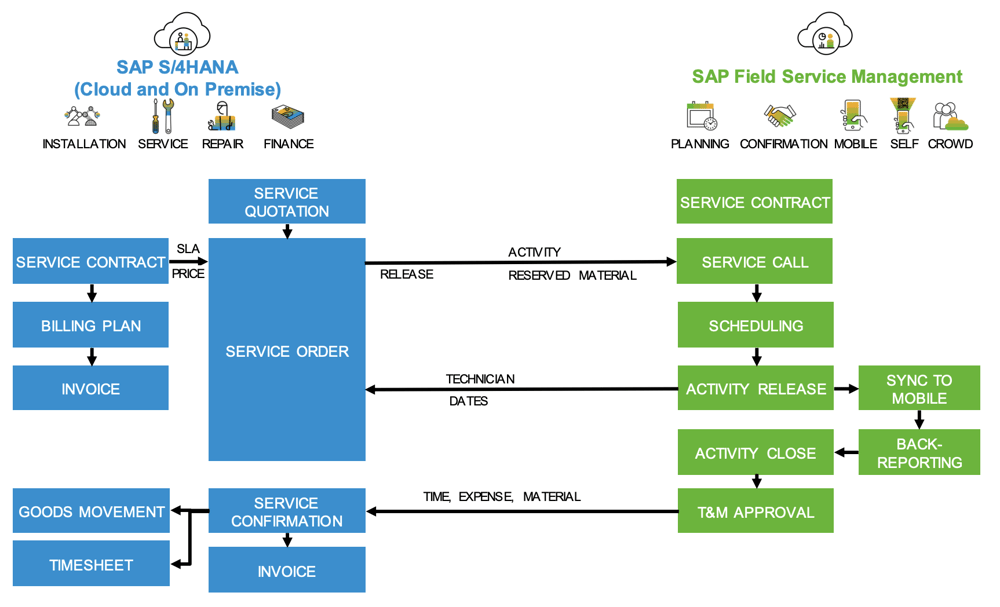
In practice, the interaction between SAP S/4HANA Service and SAP Field Service Management works as follows: SAP S/4HANA replicates a released service order to SAP FSM, where it becomes visible in the planning board. A technician suitable for the task is then assigned to the service order or activities. This can be done automatically or manually. After the assignment is released, the technician is automatically informed of the order via push notification in his mobile app and also confirms it via the app. In addition, the technician uses the app to record his efforts, spare parts and expenses, and has the customer countersign the summary of the order. Once parts and expenses have been released, SAP S/4HANA generates a service confirmation. In addition, the follow-on documents for the Cross-Application Time Sheet (CATS), goods movement, and billing request are created.
Scenario 2: Integration with SAP S/4HANA Service and SAP Service Cloud (C4C)
This scenario enables field service functionality to be used in the context of SAP S/4HANA and the SAP Customer Experience Suite. While SAP FSM implements the mobile field service – from planning to execution to feedback – the logistical and financial processing takes place in the service module of SAP S/4HANA. In addition, SAP Service Cloud (C4C) provides customer service functionalities, including the mapping of service channels, ticketing/case management, and closer integration of sales and service. In this scenario, too, standard content is already partially available in the form of iFlows via SAP Cloud Platform Integration as middleware. Additional content is placed on the SAP roadmap.
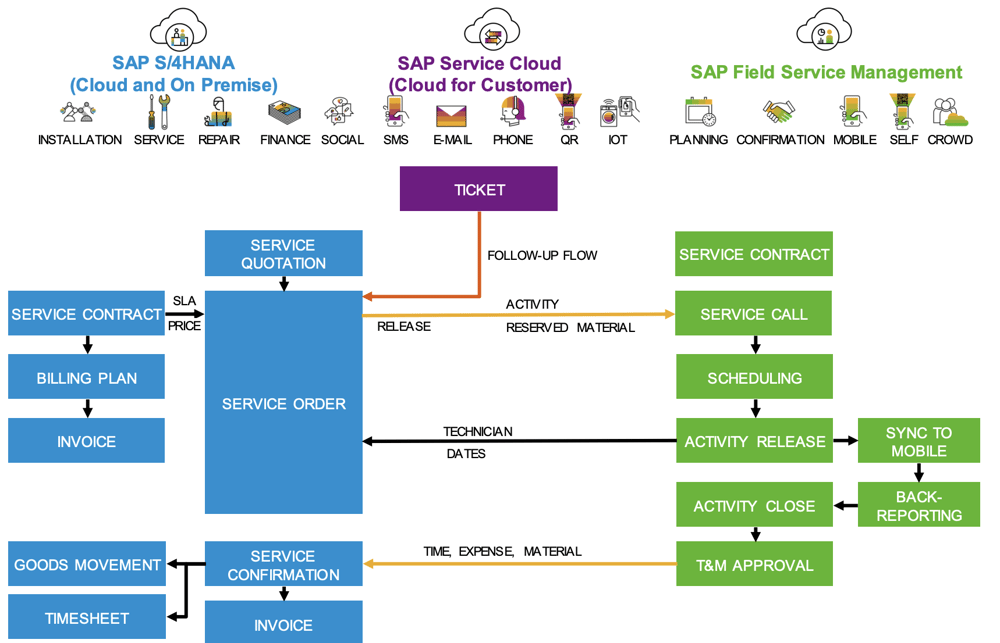
In the constellation described, SAP Service Cloud (C4C) acts as a front office, for example as a service desk. In addition, service and spare parts offers can be processed and the associated task management can be mapped in C4C. If a ticket requires on-site deployment, a follow-up service order is created in SAP S/4HANA from SAP Service Cloud. After release, the service order is replicated in SAP Field Service Management. The rest of the process is the same as in scenario 1: assignment of a technician and notification via push notification, recording of effort and spare parts, and service confirmation in SAP S/4HANA, including follow-up activities.
Scenario 3: Integration with SAP S/4HANA CS/PM or SAP ECC CS/PM
If companies have the modules Customer Service (CS) and Plant Maintenance (PM) of SAP S/4HANA or SAP EEC in use, they can also integrate field service functionalities in this context and implement mobile deployment planning and execution. In this case, the maintenance plans of the PM module initiate the on-site operations, while CS generates the service notifications and the service orders with all operations and components. Proaxia’s E4C connector is used as middleware.
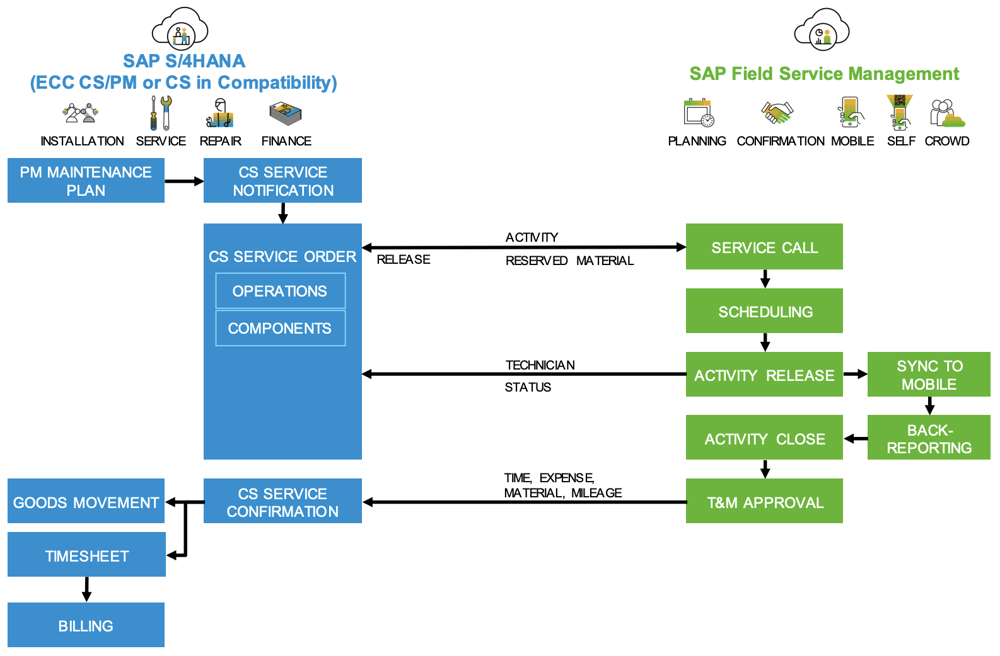
The process starts with SAP S/4HANA or SAP ECC replicating a released CS service order into the FSM planning board. The selection of the appropriate technician and his notification is followed by the confirmation of deployment and the recording of expenses and spare parts via app. Once these are released, SAP S/4HANA or SAP ECC generates a CS service confirmation and creates the follow-on documents for time recording, goods movement and billing request.
Since SAP CS will run out of maintenance at the end of 2025, companies need to address the transition to SAP S/4HANA Service in time. SAP has a best practice for this, which envisages initially docking SAP Field Service Management from SAP CS currently in use to SAP CS in a transition phase (as described in scenario 3). In perspective, SAP FSM is then to be integrated with SAP S/4HANA Service, which corresponds to scenarios 1 and 2 explained above.
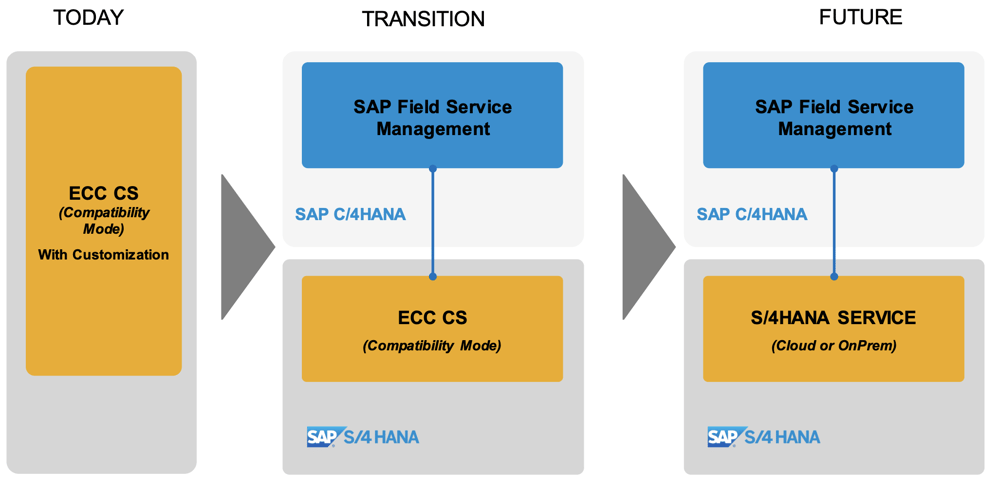
Scenario 4: Integration with SAP S/4HANA SD or SAP ECC SD and SAP Service Cloud (C4C)
Assuming that companies are already using SAP C4C in service and/or sales, there is the option of adding field service functionalities to SAP C4C Service. In addition, integration with SAP S/4HANA or SAP ECC should enable time recording, goods movement and invoicing. In this case, SAP Cloud Platform Integration is the appropriate middleware that provides standard content via iFlows.
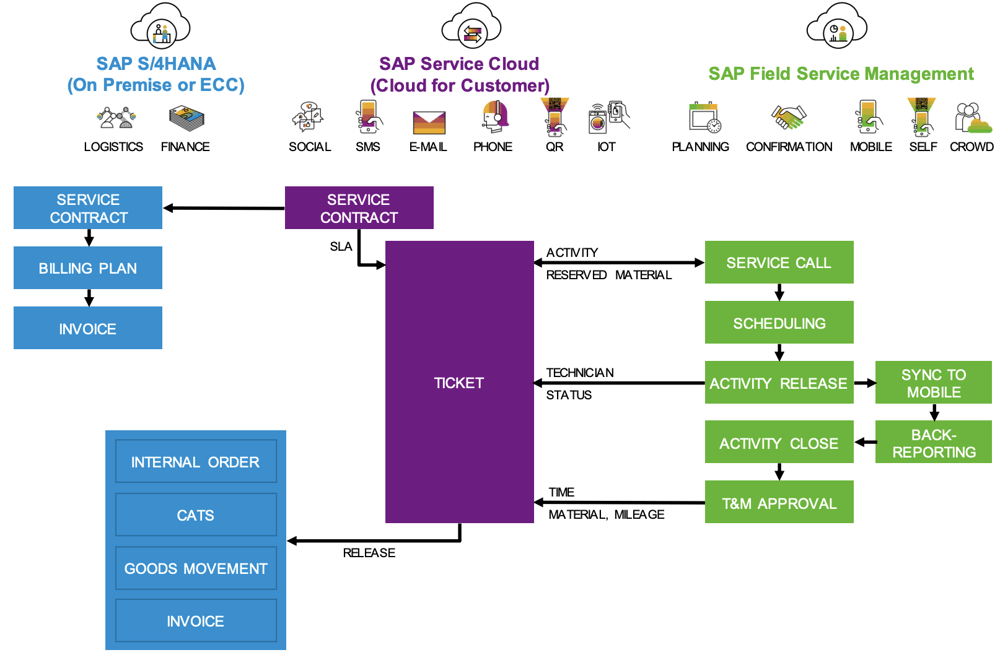
After SAP Service Cloud (C4C) replicates a ticket to the FSM planning board, automatic or manual assignment of an appropriate technician for the service order or activities takes place. The technician is automatically informed via push notification and uses the mobile app to confirm the assignment and to record effort, spare parts and expenses. A summary of the order is countersigned by the customer. Once spare parts and expenses are released, they are replicated back to the C4C ticket, which is then released to SAP S/4HANA or SAP EEC. In addition, the follow-on documents for time recording, goods movement and billing request are provided.
Conclusion: Full performance through full integration
With the help of SAP Field Service Management, companies can intelligently plan and professionally execute the service calls of their field service employees. The software achieves its entire performance capability when it is fully embedded in the rest of the IT landscape. As far as the connection to an existing ERP system and to solutions from SAP’s Customer Experience Suite is concerned, various options are available – depending on which systems companies have in use. The seamless integration of SAP Field Service Management with SAP S/4HANA, SAP ECC, SAP Service Cloud (C4C) and SAP Customer Service (CS) ensures end-to-end processes and makes SAP FSM the ideal solution for digitally mapping deployment planning and execution.
![IBacademy_Logo_blau[496] IBacademy_Logo_blau[496]](https://www.ibsolution.com/hs-fs/hubfs/IBacademy_Logo_blau%5B496%5D.jpg?width=200&name=IBacademy_Logo_blau%5B496%5D.jpg)







